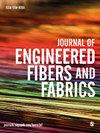男性上半身形态的分类:一种创新的方法
IF 2.3
4区 工程技术
Q1 MATERIALS SCIENCE, TEXTILES
引用次数: 0
摘要
本研究旨在提出一种新的策略,将男性人群的上半身轮廓划分为不同的形状。我们设计了基于角度的人体测量数据来捕捉上半身的曲率,而不是使用现有的基于身体线性评估的测量方案。通过量化和运用胸腰(CW)角和臀腰(HW)角来引导更合适的上半身分类,从而达到目标。研究人员通过3D人体扫描仪对241名年龄在17-29岁之间的男性进行了扫描,收集了包括胸围、腰围、臀围和身高在内的人体测量数据。在下一阶段,使用提取的信息计算角度。根据所得指标的经验实现,确定了界定体型分类的标准。通过考虑不同程度的角度差异,能够提供更显着的上半身男性体型分层,进一步丰富了操作环境。我们认识到,CW角和HW角之间的10°角差导致男性上半身的分类更加突出。本文提出的身体分类技术将241名男性样本分为三种体型:直型(61%)、沙漏型(36.51%)和火炬型(2.48%)。在本研究中提出的分类方案是一个步骤,以实现对服装合身的高度客户满意度。为今后在定制服装中实现服装合身的体型分类研究提供参考。本文章由计算机程序翻译,如有差异,请以英文原文为准。
Classification of male upper body shape: An innovative approach
This study aims at the proposition of a novel strategy to classify the upper body silhouette of the male population into different shapes. Instead of using an existing measuring scheme based on linear evaluation of the body, we devise the use of angle-based anthropometric data to capture the exhibited curvature of the upper body. The objectives are attained by quantifying and employing the chest-waist (CW) angle and hip-waist (HW) angle in the instigation of a more appropriate classification of the upper body. A sample of 241 males aged 17–29 years was scanned through a 3D body scanner to gather the anthropometric data including chest girth, waist girth, and hip girth and their respective heights. In the next phase, the extracted information was used to calculate the angles. Based on the empirical realizations of the resulting indices, criteria defining the classifications of the body shape were determined. The operational environment is further enriched by considering varying levels of angular differences capable of offering more notable stratification of the upper male body shapes. It is realized that the angular difference of 10° between the CW and HW angles results in the more prominent classification of the upper male body. The proposed body classification technique classifies the sample of 241 males into three body shapes that are, straight (61%), hourglass (36.51%), and torch shape (2.48%). The classification scheme proposed in this study is a step toward achieving a high degree of customer satisfaction regarding clothing fit. It is a reference for coming research in body shape classification to achieve clothing fit in customized clothing.
求助全文
通过发布文献求助,成功后即可免费获取论文全文。
去求助
来源期刊

Journal of Engineered Fibers and Fabrics
工程技术-材料科学:纺织
CiteScore
5.00
自引率
6.90%
发文量
41
审稿时长
4 months
期刊介绍:
Journal of Engineered Fibers and Fabrics is a peer-reviewed, open access journal which aims to facilitate the rapid and wide dissemination of research in the engineering of textiles, clothing and fiber based structures.
 求助内容:
求助内容: 应助结果提醒方式:
应助结果提醒方式:


